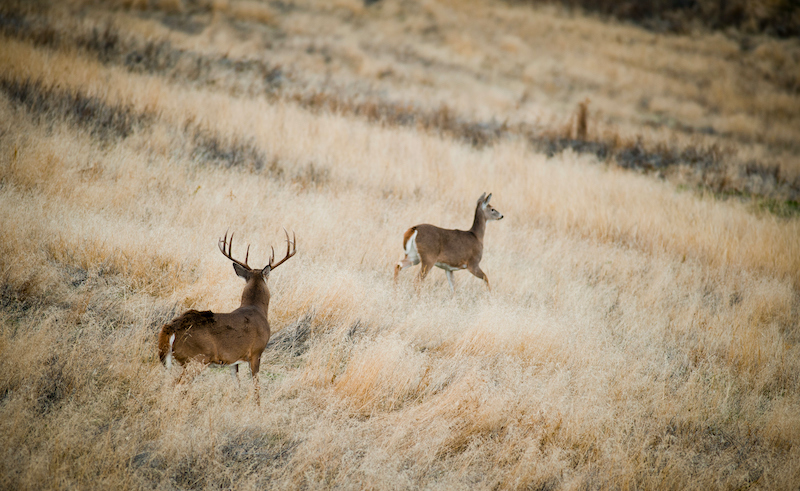Explaining, Predicting the Whitetail’s Rut
Guttural grunts interrupt the cadence of crunching leaves as a white-tail buck doggedly hounds a doe on a crisp November day.
Bowhunters spend countless hours daydreaming about the whitetail’s breeding season, aka the rut. We request time off work and spend sunup to sundown perched in ambush as we try to capitalize on these few days when bucks are most vulnerable. But what is the rut, and what tactics should bowhunters deploy to take advantage of it?
What Causes the Rut?
“Photoperiod” is the length of day all plants, animals and other life forms receive sunlight. Photoperiod decreases as days shorten, triggering changes in bucks’ behavior and physiology. Bucks are solitary creatures most of the year, and rarely move more than a few hundred yards from their bedding area except in darkness. During the rut, however, bucks become restless, even nomadic, as they seek a doe in estrus. That uptick in movement, when paired with increased aggression, often gives bowhunters their best chance to fill their freezers.
When Does it Start?
When does the rut peak? The Quality Deer Management Association notes regional differences. Northern deer have a narrow breeding window to optimize the health and survival of does and fawns. A doe’s gestation period lasts about 201 days, meaning a doe bred Nov. 1 should give birth near May 20. Citing studies across the northern United States and Canada, QDMA’s biologists report almost no variation when analyzing conception dates. Because most fawns are born from late May to early June, biologists count backward 201 days to identify peak rutting activity, which falls from Halloween to mid-November. If you’re saving time off from work or scrambling to finish home projects, mark those dates for treestand therapy sessions.
The rut isn’t as predictable with Southern deer, whose rutting activity varies by location from August to February. That wide rutting window can be attributed to milder winters and a longer calendar for births and fawn survival. A fawn born in early April in northern Wisconsin, for example, would likely starve because most foods remain buried by snow. In the South, however, food is available much earlier in spring. Deer & Deer Hunting magazine explains more about specific Southern locations and the rut’s timing in this article.
Understanding Rut Sign
As a buck strips its antler velvet, its testosterone levels start rising. They polish their headgear, and start testing their antlers. They rub trees, paw scrapes, and lick and chew overhanging branches, which become community social hubs for whitetails.
Bachelor groups of bucks that fed together in summer no longer tolerate each other. The groups break apart as the bucks determine their pecking order. They become more aggressive, making themselves more susceptible to calling tactics like rattling or grunting. Never leave home without your favorite calls during the rut. For more realism, pair a decoy with aggressive calling to lure bucks from their bedding areas and into bow range. In addition to calling, try countless other exciting tactics during the rut.
For many bowhunters, the hunting season’s best days are at hand. As Aaron Warbritton from The Hunting Public says, “It can happen at any moment.” He’s not exaggerating. A buck might walk into top-pin distance at any minute during daylight. The hunting season’s magical time is finally here. Head to your favorite spot and don’t blink. Soak in November’s precious moments.
At Bowhunting 360, we take the idea of becoming a bowhunter and make it real, dishing out fresh content covering how to hunt and where to get started. We feature bowhunting-related how-tos that focus on gear, wildlife, wild meat, and outdoor lifestyles. Through collaboration with ATA members and our outreach partners, Bowhunting 360 is the Archery Trade Association’s effort to give you the tools you need to bowhunt, regardless of your level of experience and knowledge.


